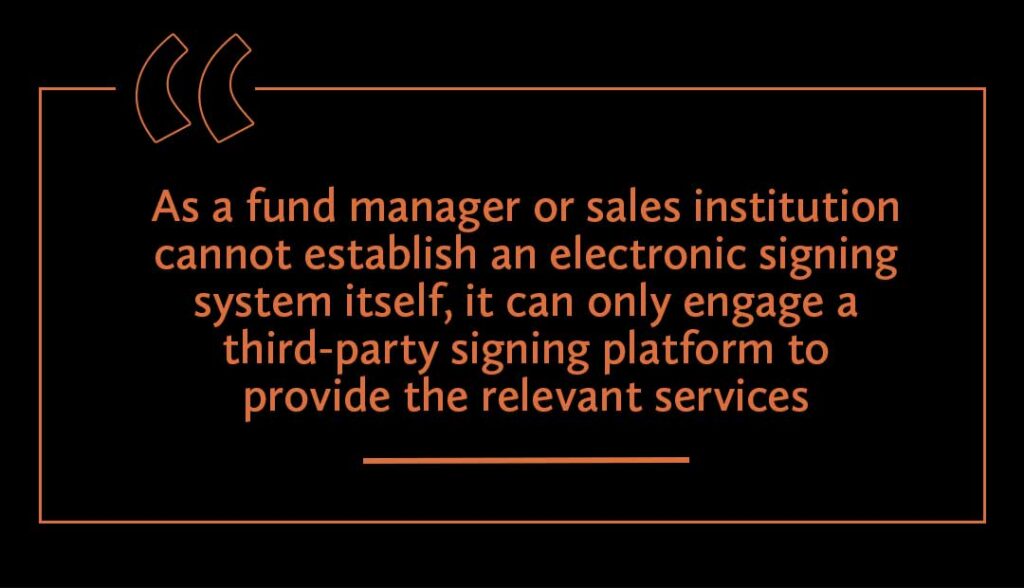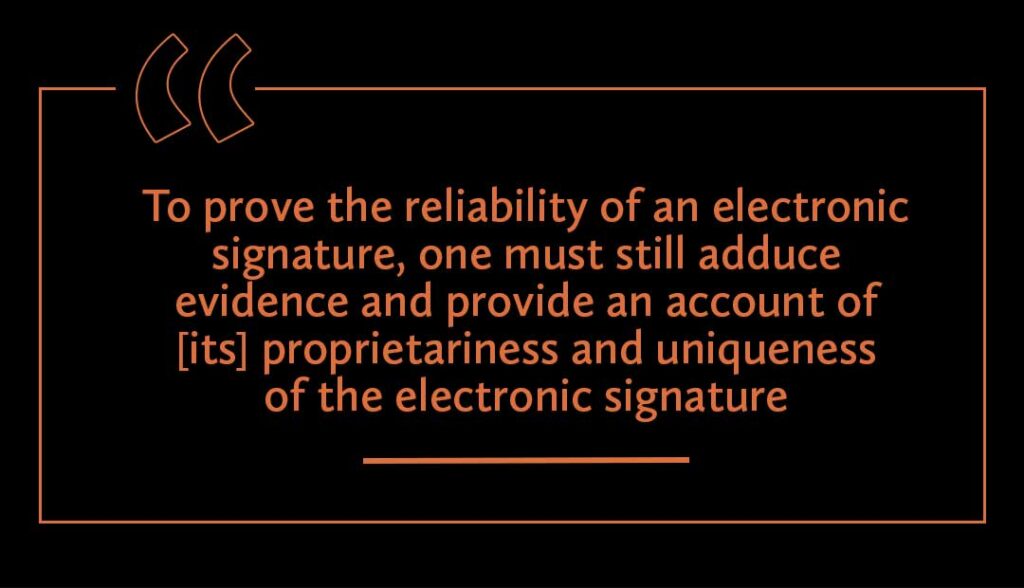The use of electronic contracts in private fund transactions is rising, yet the criteria for adjudicating these contracts lack clarity. We spoke to Zhang Guoming, chief risk officer at CITIC Securities, and Sun Jian and Kong Weilu, vice president and senior associate, respectively, at the company’s legal department, looking for clear answers on validity issues and trial rules that adjudicators can follow
With the wider use and application of electronic contracts in the private fund industry, such practical difficulties as the preservation of contract originals and the consistency of executed versions have been effectively resolved. The promulgation and implementation of both the Electronic Signature Law and the Measures for the Administration of Matters Relating to Electronic Contracts in Connection with Private Investment Funds (for Trial Implementation) have further regularised the requirements in respect of the use of electronic private fund contracts at the level of laws/statutes and industry regulations, and accord with actual needs in the innovative development of business.
At the same time, the form in which the data in an electronic fund contract is displayed inevitably gives rise to questioning and challenges: Where does the contract come from? Who executed it? Has it been altered? The list goes on. Accordingly, when a dispute arises in a private fund transaction, the criteria for the presentation of evidence for, and the determination of the validity of, an electronic private contract become primary issues of concern to all parties, and require urgent resolution.
Difficulties in practice
Despite the protection of governing laws and the support of regulatory policies, electronic private fund contracts still face certain practical difficulties in the course of their increased use.
(1) When presenting evidence, there are inconsistencies in how parties display and verify the originals of the exhibits in dispute cases for electronic contracts that have been signed online.
Pursuant to the express requirements set out in the above-mentioned measures, the electronic contract service provider may not, in principle, be the contracting party that it serves.
Accordingly, a fund manager may not itself establish an electronic contract system platform. Instead, its only option is to outsource the electronic signing service to a third-party platform and store the relevant original data on the server of the external institution for later review and downloading, as required.
In practice, parties could submit electronic contracts that differ in source or form, such as an executed electronic contract document certified and provided by the certificate institution, an executed electronic contract document directly exported by a third-party signing platform, or a screenshot printout of the contract interface of the signing platform.
As a result, when the contents of the contracts adduced by each party are inconsistent, how to confirm the version of the contract that corresponds to the original data message and whether the electronic contract document provided by the third-party platform is sufficiently credible – become a primary issue in resolving a dispute.
(2) The issue of the reliability of the signature when an electronic contract is executed directly determines whether the contract is authentic and valid.
In accordance with the law, only a reliable electronic signature has the same legal effect as a traditional handwritten signature. In practice, as the execution of an electronic contract does not require the manager or sales institution to complete offline execution with an investor face-to-face, and the form of an investor’s signature as signed online is not as identifiable as handwriting on a hard copy, managers and signing service platforms need to take additional authentication steps to ensure that when an investor signs electronically it represents his or her own genuine intent, and that such intent was not altered after completion of the signing. This makes determining the intent of the contracting party and the validity of the contract more difficult.
Presentation, validity of evidence
Based on the above-mentioned practical difficulties, we set out some reference criteria in respect of the determination of issues relevant to electronic contracts in light of current Chinese laws and regulations and industry practice.

The Civil Procedure Law and Several Provisions of the Supreme People’s Court on Evidence in Civil Procedures set out express rules on the form of originals of electronic data. As mentioned above, as a fund manager or sales institution cannot establish an electronic signing system itself, it can only engage a third-party signing platform to provide the relevant services.
Under such circumstances, the third-party signing platform becomes the “creator of electronic data” as specified in the second paragraph of article 15 of the evidence provisions, and the electronic data documents provided by it may be deemed the originals of the electronic data, making them relatively reliable for the authenticity of the form.
On this basis, if the third-party signing platform co-operates with the certificate institution, a further authoritative certification of the time of creation of the electronic data can be made, providing support for determination of the substantive authenticity.
It should be noted that the electronic contract documents submitted by a fund manager or custodian, as the entity receiving the electronic signing service, are not ipso facto valid as originals, and if the other party does not recognise them, the adjudicating body may, in light of the actual circumstances, consider taking the data created and stored by the third-party signing platform either pursuant to an application, or ex officio.
(2) Has an electronic contract been formed and entered into effect?
Based on the specific features of electronic contracts themselves, the key to determining whether an electronic contract has been formed and entered into effect lies in identifying the signatory and determining the authenticity and validity of his or her electronic signature. More specifically, this includes the following factors involved in making the determination:
(i) The signatory of an electronic contract must have the civil capacity to act. Thanks to the development of the internet and information technology, an electronic contract signing service platform can, in practice, now access public security, UnionPay, telecoms, market supervision and other such systems through an application programming interface, through which the caller can access the data information of other entities or on other servers by sending a network request. The signatories can then be identified by cross-combining means such as checking a resident ID card, facial recognition, bank card verification and cell phone verification to ensure that execution of the contract can only occur after the identity of the signatory is confirmed. Accordingly, the risk of a signatory with no or limited civil capacity to act signing an electronic contract directly, or doing so on behalf of a third party, is greatly reduced.
(ii) Determination of a “reliable electronic signature”. Article 13 of the Electronic Signature Law brings in the concept of a “reliable electronic signature”. Pursuant to the provision in question, the authors argue that the genuine intent of a contracting party may be determined by examining such features of an electronic signature as its proprietariness, uniqueness and unalterability.
“Proprietariness” means that the electronic signature creation data, when used for electronic signatures, is proprietary to the electronic signatory. “Electronic signature creation data” refers to such data as characters, symbols and codes used in the course of electronic signing that reliably link the electronic signature with the electronic signatory. Relying on such proprietary electronic signature data, the contracting party can be identified with precision to a particular individual without the possibility of confusion with another person or forgery.
In practice, the adjudicating body may focus on whether the third-party electronic signing service platform is able to denote the electronic signatory by such means as his or her resident ID card, or cell phone verification code. If it can be ensured that the electronic signature is associated with the signatory’s identity information, and there is no likelihood of confusion or the same being easily forged, then the requirement of proprietariness may be deemed to be satisfied, i.e. the electronic data associated with the performance of the signing act exclusively belong to the electronic signatory.
- “Uniqueness” emphasises that the electronic signature creation data are under the sole control of the electronic signatory at the time of execution.
As compared with proprietariness, uniqueness emphasises even more strongly that at the time of the signing, the electronic signature creation data are controlled solely by the electronic signatory, thus ensuring that there is no possibility of the electronic signature data being passed off by a third party.
It is the authors’ opinion that the degree of protection offered by using only the verification method that combines an electronic signing platform login account number and a static password is exceedingly low and, in general, is insufficient to ensure the requirement of uniqueness. This shortcoming can be remedied to a certain extent by using an account number and password plus a cell phone real-time SMS verification code.
If, on this basis, the further step of using a biometric feature, such as face recognition or a fingerprint as a verification method before execution of a contract is taken, stronger authentication and greater substitution difficulty is provided, giving a method of authentication that is even more closely associated with the signatory himself or herself. With identification and authentication conducted using these biometric features at the time of execution of a contract, the electronic signature can be deemed to satisfy the requirement of uniqueness, and the act of entering into the contract to have been performed by the signatory himself or herself. - “Unalterability” has two aspects. First, the ability to detect any alteration made to the electronic signature after execution can be detected, and second, the ability to detect any alteration made to the substance and format of the data message after execution can be detected.
In practice, control of this factor is usually realised through the collection and fixation of materials such as trusted time stamps, hash value checks or blockchain. The Provisions of the Supreme People’s Court on Several Issues Concerning the Trial of Cases by Internet Courts supports the recognition of the authenticity of electronic data by the above-mentioned means.However, it should be noted that although trusted time stamps, hash value verification and blockchain authentication can provide evidence for the accurate time of creation of an electronic contract, and that the electronic contract was not altered after being signed electronically, they cannot verify the identity of the electronic signatory. Accordingly, if it is necessary to prove the reliability of an electronic signature, one must still adduce evidence and provide an account of the proprietariness and uniqueness of the electronic signature.
(iii) Validity of electronic signature authentication certificates. With the wider use and application of electronic signatures, certain third-party electronic certification authorities have emerged in the market. Following authentication of an electronic signature, they issue an electronic signature authentication certificate, thereby providing, in judicial practice, strong proof of the electronic contract execution process, and the authenticity and validity of the electronic signatures.
The information recorded on a certificate generally includes such relevant details as the signatory of the electronic signature, the content of the contract, the time of execution and whether the contract has been altered, providing great assistance to adjudicating bodies in their review of the validity of electronic contracts.
China currently subjects certification authorities to a strict market access system, requiring them to undergo a stringent application review process and submit themselves to oversight by multiple relevant state authorities. As a result, the certificates issued by them enjoy a high level of probative force and can be used by adjudicative bodies for the confirmation of authenticity, and thus be employed in determining the reliability of electronic signatures.
The Guidelines for the Conclusion of Electronic Employment Contracts issued by the General Office of the Ministry of Human Resources and Social Security also contain a relevant provision: “For electronic signatures, employers and workers shall use digital certificates and keys complying with the requirements of the Electronic Signature Law and issued by electronic certification service institutions established in accordance with the law.”
Accordingly, in the trial of a case involving an electronic contract, if a dispute arises between the parties over whether the contract is valid, the adjudicating body may, in rendering its finding, refer to the authoritative certification provided by a certification authority.
A certificate is not the sole means of determining the reliability of an electronic signature, however. Authentication by a certification authority is not found among the four elements for determining the reliability of an electronic signature specified in article 13 of the Electronic Signature Law. From this, it can be seen that use of a certificate is neither sufficient nor necessary as a condition for determining the validity of an electronic signature. If an adjudicating body, by comprehensively considering the case evidence, can confirm that the proprietariness, uniqueness and unalterability specified in article 13 of the Electronic Signature Law are satisfied, it can directly render a finding of validity without further increasing the burden of proof borne by the parties.
(iv) Separation of the points in time when an electronic contract is formed and when it enters into effect. In the course of a private fund, there can exist a situation in which the points in time when a contract is executed and formed and when it actually enters into effect are separate. Specific scenarios include the fund contract forming upon its execution and sealing by the parties, but entering into effect only after completion of the fund offering or confirmation of the fund units, or the fund contract forming upon execution and sealing of a supplementary agreement by the parties, but entering into effect only after completion of execution by the manager, the custodian and all of the investors.
The execution of a fund contract or a supplementary agreement relating to it in electronic format will not, in itself, conflict with the rules of common practice, but the possible changes brought about by a supplementary agreement to the fund contract itself still deserve the attention of the adjudicating body.
A fund contract in electronic format enjoys the convenience of easy revision of the data message, and revisions of the fund contract in the form of a supplementary agreement can be accomplished in one of two ways: directly revising the original of the fund contract; or attaching a separate supplementary agreement while leaving the original of the fund contract unchanged. Clearly, the latter better satisfies the requirement of unalterability under the Electronic Signature Law.
If any party to a dispute brings forward an altered version of a supplementary agreement that directly revises the original of the fund contract, the adjudicator should require the party in question to provide a detailed additional explanation and adduce evidence of the process of revision of the relevant data message to show that the other signatories still have the intent of being bound by the revised contract text.
In any one case when all the parties recognise the validity of a supplementary agreement, the adjudicator still needs to carefully ascertain whether the supplementary agreement has been executed by all the investors and formally entered into effect, failing which it cannot become an agreement that is valid in the legal relationship in question.
Conclusion
In their widening use and development, electronic private fund contracts will inevitably face numerous difficulties and challenges. The understanding of these issues and the responses to them depend on the adjudicating body rendering an accurate, fair and reasonable finding on whether an electronic contract is formed and entered into effect, based on the form of the evidence for the electronic contract and in light of the criteria for determining the reliability of an electronic signature and the relevant factual and legal bases.
Doing so can further clarify the relationship of the rights and responsibilities of each party, resolve practical disagreements, and ensure the long-term and stable development of the private fund industry.






 “Proprietariness” means that the electronic signature creation data, when used for electronic signatures, is proprietary to the electronic signatory. “Electronic signature creation data” refers to such data as characters, symbols and codes used in the course of electronic signing that reliably link the electronic signature with the electronic signatory. Relying on such proprietary electronic signature data, the contracting party can be identified with precision to a particular individual without the possibility of confusion with another person or forgery.
“Proprietariness” means that the electronic signature creation data, when used for electronic signatures, is proprietary to the electronic signatory. “Electronic signature creation data” refers to such data as characters, symbols and codes used in the course of electronic signing that reliably link the electronic signature with the electronic signatory. Relying on such proprietary electronic signature data, the contracting party can be identified with precision to a particular individual without the possibility of confusion with another person or forgery.


